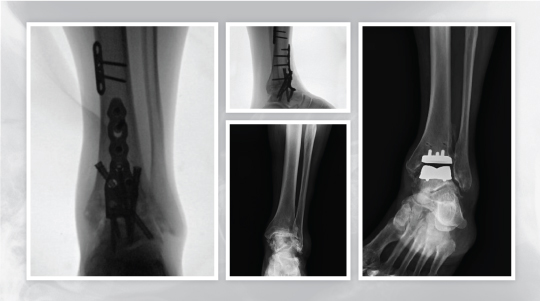Ankle Sprain
What is an Ankle Sprain?
Ligaments are tough, fibrous bands of tissue that connect and stabilize the bones forming a joint. A sprained ankle occurs when the ligaments, which hold together the ankle bones, are forced beyond their normal range of motion and stretch and subsequently tear. There are four primary ligaments that stabilize the ankle. The greater number of these ligaments injured the worse the injury. A more significant sprain may be assonated with increased swelling and the inability to walk.
Ankle sprains are one of the most common orthopedic injuries and account for approximately 2 million injuries every year and up to 20 percent of sports-related injuries.
Despite the high frequency of these injuries, they generally improve with supportive care including rest, bracing, physical therapy and ice. Repeated ankle injuries are thought to cause long-term problems in the ankle due to weakened ligament, damage to the cartilage of the ankle leading to arthritis and ongoing ankle pain and swelling.
Ankle Sprain Symptoms
Signs and symptoms of a sprained ankle vary depending on the severity of the injury, including:
- Bruising / discoloration of the ankle and/or foot
- Difficulty weightbearing on the injured side
- Pain and swelling
- Popping sensation or sound when the injury occurs
- Restricted range of motion
- The sensation of the ankle “giving way”
- Stiffness
- Tenderness to the touch
Ankle Sprain Causes and Risk Factors
Typically, the ankle twists outward (lateral) stretching and/or tearing the ligaments on the outer ankle. Occasionally there is a rotational injury where the foot rolls inward or is trapped behind the body that injuries the ligaments between the leg bones (high ankle sprain).
Some examples include the following:
- Falling down
- Walking / running on an uneven surface
- Exercising on an uneven surface
- Sports requiring jumping, rolling, twisting, and cutting actions of the foot, such as trail running, hiking, rock climbing, basketball, tennis, football, and soccer
- A sports activity where the foot is stepped on while running, causing the foot to twist or roll to the side
Diagnosing an Ankle Sprain
Diagnosis of an ankle sprain by an experienced UOA physician typically involves an understanding of the injury mechanism, a patient examination and x-rays. The examination often requires mechanical testing of the ankle ligaments. Often, specialized stress x-rays or an MRI may be required to evaluate the stability of the ankle joint to direct treatment.
Ankle Sprain Treatment
Most ankle sprains can be treated non operatively. Treatments include rest, immobilization, use of a walking boot/brace, anti-inflammatory medication, ice, compression and physical therapy. Typically, these reduce pain and swelling to rebuild strength, stability and balance to resume activity. In general, the greater the injury the longer the rehabilitation and recovery process can take. Complete recovery can often take three months.
Occasionally, surgical management is necessary to repair injured ligaments and damaged cartilage in the ankle joint. This is seen with both lateral ankle and high ankle sprains.
Ankle Sprain Prevention
The best way to avoid chronic ankle sprains is to focus on prevention. Some prevention tips include:
- Warming up before exercising or playing sports
- Being mindful when walking or running – watch for uneven surfaces
- Using an ankle brace for stabilization of a previously injured ankle
- Practicing stability and balance exercises
- Strengthening muscles
- Increasing flexibility
- Decreasing the use of high-heeled shoes
- Wearing the appropriate shoes for a particular activity
- Not participating in sports when out of shape or currently injured
If you are experiencing ankle pain or think you may have a sprained ankle, schedule an appointment with us today to discuss your treatment options.




